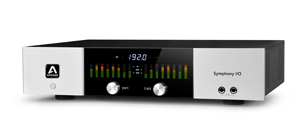Apogee Intros Symphony I/O Multichannel Audio Interface
Apogee Electronics has announced its new Symphony I/O multi-channel audio interface with “next-generation converter quality,” Logic and Pro Tools compatibility and total I/O flexibility.
Symphony I/O is a modular based system which can function in StandAlone Mode or connect directly to a Mac via any Mac-based audio workstation.
With flexible and scalable I/O architecture, the new Symphony System now allows end-users to define a system to their specific needs while benefiting from a new feature set which includes “ground-breaking digital audio conversion technology” and new Maestro 2 software.
Symphony I/O’s base chassis can accommodate up to 2 I/O modules, creating any combination of analog and digital I/O with USB 2.0, Symphony and Avid’s Pro Tools connectivity.
The new Maestro 2 offers integral control of Symphony I/O with a “clean and clear software interface that makes workflow easy by removing the guesswork from routing, mic pre adjustment, input and output calibration and hardware control.”
Connect Symphony I/O to the Symphony 64 PCI or Symphony Mobile Express/34 card for ultra low latency with Apple Logic, and all Apple Core Audio applications.
Symphony I/O systems will be available starting in August and starting at $3,690.
Current Symphony I/O modules include:
8 Analog I/O + 8 Optical I/O
8 Analog I/O + 8 AES I/O
8 Mic Preamp
16 Analog IN + 16 Optical OUT
16 Analog OUT + 16 Optical IN
Audio Interface Mode (AIM): Configure Symphony I/O from the front panel for these modes:
– Symphony (connect to Symphony PCIe card or Symphony Mobile Express/34 card for ultra low latency use with Logic or any Core Audio application)
– Pro Tools HD (connect directly to Pro Tools PCIe card)
– USB (connect to high-speed USB 2.0 port)
– StandAlone (I/O inputs routed directly to I/O outputs)
Front panel control including two encoder knobs for selectable input gain and output level adjustment and sixteen (16) high-resolution meters, audio system and clocking indication
Two (2) studio quality headphone outputs
Four (4) word clock connections
Ethernet and USB computer connectivity to be available with a future firmware update.
Available with feet for desktop use or rack ears for rack mounting
Maestro 2 allows control of all Apogee hardware inputs, outputs, low latency monitoring and routing paths for single or multiple devices. The new version has a completely redesigned interface featuring a single window design and quick/easy access to essential controls such as audio system, clocking, sample rate, headphone output and output level.
For more information and a full release schedule, visit Apogee at http://www.apogeedigital.com.
Please note: When you buy products through links on this page, we may earn an affiliate commission.







